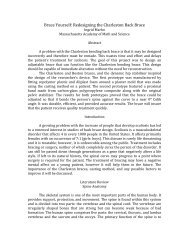Glasswork - the Scientia Review
Glasswork - the Scientia Review
Glasswork - the Scientia Review
Create successful ePaper yourself
Turn your PDF publications into a flip-book with our unique Google optimized e-Paper software.
The Art of<br />
<strong>Glasswork</strong><br />
By<br />
CHRIS STARBARD<br />
and<br />
BECCA CHURCH
Flashed, Cased,<br />
and Stained<br />
Three kinds of colored glass called flashed, cased, and<br />
stained glass, are named after <strong>the</strong> methods used to color <strong>the</strong>m.<br />
Flashed and cased glass are similar in that <strong>the</strong> color is applied<br />
through a separate of glass, while stain is painted on. These<br />
processes will be explained in more detail on <strong>the</strong> next page.<br />
Flashed<br />
Glass<br />
Cased<br />
Glass<br />
11<br />
Stained<br />
Glass
All processes begin with an annealed, or<br />
cooled, colorless glass object. Flashed glass is colored when<br />
a clear glass object is dipped into molten colored glass to be<br />
coated in a thin layer. Cased glass also has layers of colored<br />
glass added on, but usually multiple layers of different colors<br />
are applied. Then areas of <strong>the</strong> glass are cut into to reveal<br />
different colors. Stained glass is created when <strong>the</strong> glass<br />
object is coated with a chemical stain. Then <strong>the</strong> glass is fired<br />
and <strong>the</strong> color of <strong>the</strong> chemical is developed by <strong>the</strong> heat.<br />
An elaborate<br />
example of cased<br />
glass in which<br />
<strong>the</strong> blue glass<br />
was chiseled and<br />
cut away in a<br />
pattern to reveal<br />
<strong>the</strong> white.<br />
12
Coloring with Metallic<br />
Salts<br />
Minerals and purified metallic salts are commonly<br />
used as pigments to color glass. Natural impurities in <strong>the</strong><br />
sands or smoke involved in glassmaking can cause discoloration<br />
in glass, as was often <strong>the</strong> case with earlier glass. For example,<br />
iron in <strong>the</strong> sand and sulfur in <strong>the</strong> smoke of <strong>the</strong> burning coals<br />
burned to make English “black bottle glass” in <strong>the</strong> 17 th century<br />
produced a dark hue in <strong>the</strong> glass. However, nowadays <strong>the</strong>se<br />
impurities are often removed to make clear glass to be colored<br />
only by selected metallic salts. Manganese dioxide and cerium<br />
oxide are commonly used decolorizers, chemicals that precipitate<br />
out, or cause to be deposited in solid form from a liquid, <strong>the</strong><br />
impurities.<br />
Black Bottle<br />
Glass from <strong>the</strong><br />
17 th Century<br />
13
Chemistry of Color<br />
Each chemical used to color glass develops its own distinct<br />
color and some also remove o<strong>the</strong>r colors due to impurities. Iron oxides<br />
tend to create green and brown colors. Manganese oxides are used to<br />
remove greens but can also develop a deep amber or amethyst color in<br />
larger amounts. Reds can by formed by gold chloride, selenium<br />
compounds, and some copper compounds. Whites can be derived from<br />
glass with tin compounds or antimony oxides, while black comes from a<br />
mix of manganese, cobalt, and iron. Cobalt oxide and copper<br />
compounds can lead to blue glass. Carbon oxides and sulfur<br />
compounds cause glass to be amber or brown. Perhaps <strong>the</strong> most<br />
fascinating chemically formed color is <strong>the</strong> yellow-green glass produced<br />
by <strong>the</strong> addition of uranium oxides – this glass actually glows under<br />
ultra-violet light!<br />
Uranium<br />
glass<br />
glowing<br />
under a<br />
UV light<br />
14
Fusing <strong>the</strong> Color<br />
Stained glass, as<br />
described on page 12, must be<br />
fired to develop <strong>the</strong> color of <strong>the</strong><br />
stain and fuse it with <strong>the</strong> glass.<br />
The heating process required to<br />
seal <strong>the</strong> color to <strong>the</strong> glass is<br />
carried out in a kiln, or an oven or<br />
The Lehr<br />
A lehr is a type of kiln<br />
used specifically for<br />
glasswork. It is used<br />
for <strong>the</strong> process or<br />
annealing glass. It<br />
helps stabilize <strong>the</strong><br />
temperature distribution<br />
in glass objects to<br />
reduce <strong>the</strong> stress on <strong>the</strong><br />
glass and <strong>the</strong>refor<br />
prevent cracking.<br />
<strong>the</strong>rmally insulated chamber used<br />
to control temperatures necessary<br />
for various processes, such as<br />
annealing glass.<br />
15
Preservation<br />
The breakdown of glass depends most directly upon<br />
composition. Glass contains silica, alkali, and minute amounts of<br />
calcium as primary constituents, and <strong>the</strong>se ingredients each effect <strong>the</strong><br />
breakdown process Though glass is somewhat uniform in<br />
composition, small differences in makeup account for large differences<br />
in <strong>the</strong> breakdown process. Some types of Roman glass, for example,<br />
are extremely resistant to breakdown, unlike much medieval glass<br />
which degenerates with ease due to a high potash content; <strong>the</strong> potash<br />
from beech wood renders <strong>the</strong> composition unstable.<br />
16
Water is <strong>the</strong> most primary mechanism of decomposition.<br />
It forms a number of acidic solutions with ease and without special<br />
conditions. The resultant mild acids withdraw alkali from <strong>the</strong> silica<br />
structure of <strong>the</strong> glass. The removal of this substance renders <strong>the</strong> core<br />
material weak, but also harms <strong>the</strong> surface; at <strong>the</strong> surface, alkaline<br />
compounds actually retain water and catalyze <strong>the</strong> degradation<br />
process. When glass reaches this state, <strong>the</strong> surface often feels<br />
slippery, and this effect is referred to as weeping. The alkali removal<br />
causes visible cracks to develop which account for a cloudy<br />
appearance. Heightened alkali withdrawal results in flaking.<br />
Extreme <strong>the</strong>rmal fluctuation also poses a threat by creating forces<br />
between <strong>the</strong> glaze and base of a glass, often separating <strong>the</strong>se adjacent<br />
layers.<br />
17
History of Leaded Glass<br />
The use of lead additives in glassmaking originates in<br />
Mesopotamia, which scholars generally agree upon as <strong>the</strong> origin<br />
of <strong>the</strong> glass craft. Recipes for lead-based glass have been found<br />
inscribed upon Mesopotamian in addition to actual colored<br />
fragments. Interestingly, recovered shards display a relatively<br />
low amount of lead, and it is possible that in some case <strong>the</strong><br />
inclusion of lead was entirely accidental or experimental. Ancient<br />
lead glass discovered in China is much newer and suggests that<br />
practice is not as deeply rooted. Medieval glassworkers added<br />
Lead compounds intentionally in <strong>the</strong> greatest amounts; <strong>the</strong>se<br />
substances proved well suited not only for painting stained glass<br />
but also for integral pigmentation.<br />
18
Lowered viscosity and working temperature rendered<br />
lead as an advantageous addition to glass; period technology could<br />
not provide high temperatures or function well with excessively<br />
hot material. George Ravenscroft revolutionized <strong>the</strong> glassmaking<br />
trade by using flint in large scale glass production. Eventually,<br />
his product utilized sand ra<strong>the</strong>r than flint and contained a<br />
significant concentration of lead oxide. The result was <strong>the</strong> clear<br />
lead crystal which now typifies leaded glass. He received several<br />
patents for his work, and provided an alternative to <strong>the</strong> shoddy<br />
material supplied by Italy.<br />
19
Chemistry of Leaded Glass<br />
Lead oxide, as an additive in glass production, is highly<br />
effective because it causes <strong>the</strong> material to be more fluid when molten<br />
and lowers <strong>the</strong> temperature at which <strong>the</strong> material may be<br />
manipulated. Those qualities were highly advantageous<br />
historically because antique technology could not provide<br />
excessively high temperatures and because more viscous material<br />
required less effort to form. Lead is not added strictly as lead but<br />
ra<strong>the</strong>r as lead oxide. As an oxide, it prevents <strong>the</strong> deterioration of<br />
alkali structures within <strong>the</strong> glass and thus prevents <strong>the</strong> major<br />
cause of breakdown.<br />
20
Glossary<br />
Anneal – To heat and <strong>the</strong>n cool glass to increase <strong>the</strong><br />
strength and durability of <strong>the</strong> material. (p. 12)<br />
Cased Glass – Clear glass with layers of colored glass<br />
applied and chipped away. (p. 12)<br />
Decolorizers – Chemicals that precipitate out impurities<br />
that cause discoloration. (P. 13)<br />
Flashed Glass – Clear glass dipped in a layer of colored<br />
glass. (p. 12)<br />
Kiln - An oven or <strong>the</strong>rmally insulated chamber used to<br />
control temperatures necessary for various processes. (p.<br />
15)<br />
Lead Cames – Grooved lead bars that hold toge<strong>the</strong>r glass and<br />
sometimes act as panes in stained glass windows. (P. 3)<br />
Leadlights – Sections of glass supported by lead cames,<br />
often as decorative windows. (p. 4)<br />
Medium – The category of a work of art or <strong>the</strong> materials used<br />
to create it. (P. 2)<br />
Precipitate – cause to be deposited in solid form from a<br />
liquid (P. 13)<br />
Solder – Two use a low-melting combination of metals to join<br />
metals that do not melt as easily. (P. 3)<br />
Stained Glass – Glass onto which a stain is painted and <strong>the</strong>n<br />
<strong>the</strong> entire glass item is heated to fuse <strong>the</strong> stain to <strong>the</strong><br />
glass. (P. 12)<br />
21
About <strong>the</strong><br />
Authors<br />
Chris Starbard is a hard-working,<br />
friendly mass academy student from<br />
Oakham, Massachusetts. In his free<br />
time he enjoys working on,<br />
collecting, and riding antique<br />
bicycles.<br />
Becca Church is a bubbly Mass Academy<br />
student from Northborough,<br />
Massachusetts. Her hobbies include<br />
singing, drawing, writing poetry, and<br />
playing <strong>the</strong> piano.<br />
22
Illustration Credits<br />
Page 1 – Wikipedia.org<br />
Page 2 – flickriver.com<br />
Page 3 – Wikipedia.org<br />
Page 19 – vam.ac.uk<br />
Page 20 –apartment<strong>the</strong>rapy.com<br />
Page 4 – classicglass.com<br />
Page 5 – scottspeck.com<br />
Page 7 – en.murano-glass-shop.it<br />
Page 8 – <strong>the</strong>ageofelegance.com<br />
Page 9 – glazette.com<br />
Page 10 – mdiglass.com<br />
Page 11 – patternglass.com<br />
Page 12 – antiquie-marks.com<br />
Page 13 – antique-bottles.com<br />
Page 14 – Wikipedia.org<br />
Page 15 – vintage-technology.info<br />
Page 16 – yorkminster.org<br />
23

















